Report on John's Nursing Care: Assessments, Medications, and Education
VerifiedAdded on 2021/04/17
|9
|1437
|52
Report
AI Summary
This report details the nursing care provided to John, a patient with cellulitis and a bacterial infection, complicated by a history of chronic anxiety. The report begins with priority nursing assessments, including wound assessment, vital signs, and IV cannula assessment. It explains the necessity for nursing care, the consequences of incomplete assessments, and the rationale for prescribing Gentamycin and Ibuprofen. Nursing responsibilities associated with medication administration are outlined, along with assessments for potential adverse effects. The report addresses nursing assessments on deterioration, appropriate nursing interventions, and patient education for discharge planning, including medication adherence, wound care, and anxiety management. The report emphasizes the importance of continuous monitoring and patient education to ensure optimal outcomes and prevent complications.
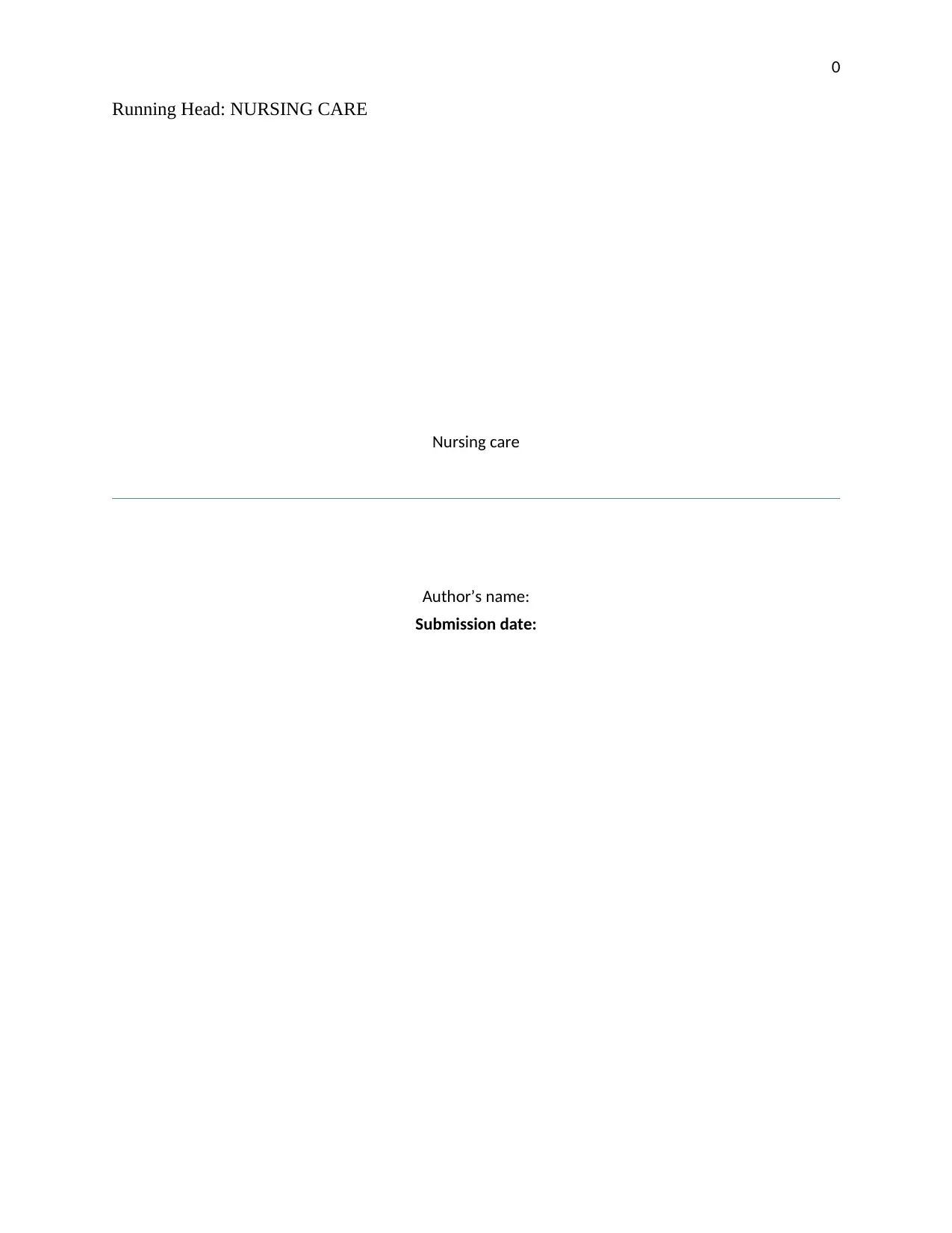
0
Running Head: NURSING CARE
Nursing care
Author’s name:
Submission date:
Running Head: NURSING CARE
Nursing care
Author’s name:
Submission date:
Paraphrase This Document
Need a fresh take? Get an instant paraphrase of this document with our AI Paraphraser
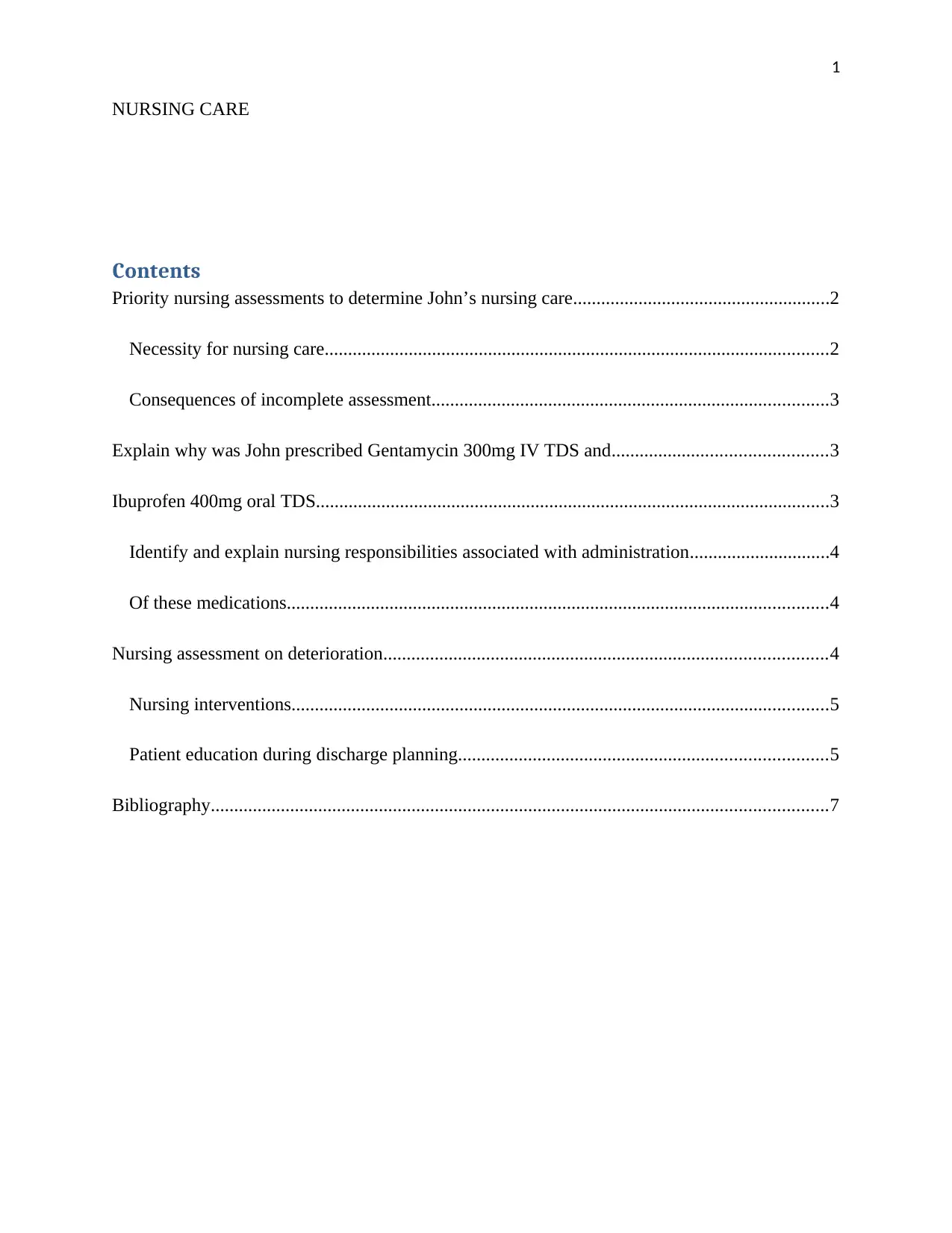
1
NURSING CARE
Contents
Priority nursing assessments to determine John’s nursing care.......................................................2
Necessity for nursing care............................................................................................................2
Consequences of incomplete assessment.....................................................................................3
Explain why was John prescribed Gentamycin 300mg IV TDS and..............................................3
Ibuprofen 400mg oral TDS..............................................................................................................3
Identify and explain nursing responsibilities associated with administration..............................4
Of these medications....................................................................................................................4
Nursing assessment on deterioration...............................................................................................4
Nursing interventions...................................................................................................................5
Patient education during discharge planning...............................................................................5
Bibliography....................................................................................................................................7
NURSING CARE
Contents
Priority nursing assessments to determine John’s nursing care.......................................................2
Necessity for nursing care............................................................................................................2
Consequences of incomplete assessment.....................................................................................3
Explain why was John prescribed Gentamycin 300mg IV TDS and..............................................3
Ibuprofen 400mg oral TDS..............................................................................................................3
Identify and explain nursing responsibilities associated with administration..............................4
Of these medications....................................................................................................................4
Nursing assessment on deterioration...............................................................................................4
Nursing interventions...................................................................................................................5
Patient education during discharge planning...............................................................................5
Bibliography....................................................................................................................................7

2
NURSING CARE
Priority nursing assessments to determine John’s nursing
care
During nursing care, the following nursing assessments should be conducted on John;
wound assessment, vital signs assessment, and IV cannula assessment (Ginger, 2016). After
receiving John’s report from the ward nurse the first thing to do is to assess the IV cannula site,
for signs of infections, because it is an artificial opening into the blood system that can easily
carry infections if not used aseptically (Davidson, 2016), also inspect it for patency to determine
if he needs a new one or not and assess how long it has stayed in situ, because the longer it has
stayed the higher the chances of getting an infection. John’s vital signs that is blood pressure,
respiratory rate, temperature, pulse rate, heart rate, oxygen saturation rate, pain score, alertness,
and urinary output should be given priority during assessment, because they are the earliest
indicators of an infection and how well the physiologic processes are taking place, they should
always be within the normal range. Wound assessment is another priority assessment; the wound
is assessed for signs of infection and exudation because they indicate the healing process.
Necessity for nursing care
John requires total nursing care because he has cellulitis and bacterial infection from the
wound. He is on Intravenous medication with gentamycin which should be monitored carefully
due to nephrotoxicity and the wound should be monitored as it heals to minimize complications.
NURSING CARE
Priority nursing assessments to determine John’s nursing
care
During nursing care, the following nursing assessments should be conducted on John;
wound assessment, vital signs assessment, and IV cannula assessment (Ginger, 2016). After
receiving John’s report from the ward nurse the first thing to do is to assess the IV cannula site,
for signs of infections, because it is an artificial opening into the blood system that can easily
carry infections if not used aseptically (Davidson, 2016), also inspect it for patency to determine
if he needs a new one or not and assess how long it has stayed in situ, because the longer it has
stayed the higher the chances of getting an infection. John’s vital signs that is blood pressure,
respiratory rate, temperature, pulse rate, heart rate, oxygen saturation rate, pain score, alertness,
and urinary output should be given priority during assessment, because they are the earliest
indicators of an infection and how well the physiologic processes are taking place, they should
always be within the normal range. Wound assessment is another priority assessment; the wound
is assessed for signs of infection and exudation because they indicate the healing process.
Necessity for nursing care
John requires total nursing care because he has cellulitis and bacterial infection from the
wound. He is on Intravenous medication with gentamycin which should be monitored carefully
due to nephrotoxicity and the wound should be monitored as it heals to minimize complications.
⊘ This is a preview!⊘
Do you want full access?
Subscribe today to unlock all pages.

Trusted by 1+ million students worldwide
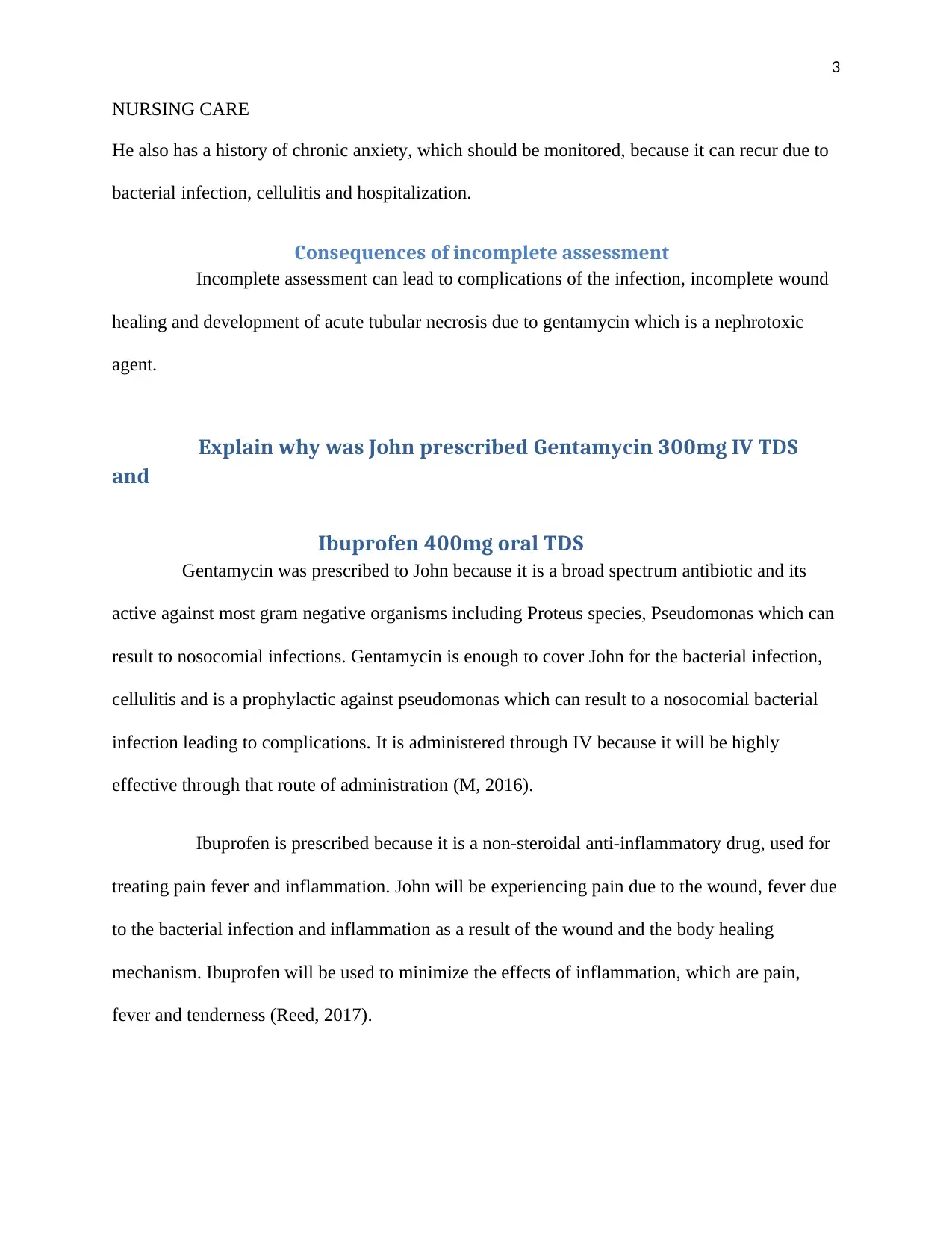
3
NURSING CARE
He also has a history of chronic anxiety, which should be monitored, because it can recur due to
bacterial infection, cellulitis and hospitalization.
Consequences of incomplete assessment
Incomplete assessment can lead to complications of the infection, incomplete wound
healing and development of acute tubular necrosis due to gentamycin which is a nephrotoxic
agent.
Explain why was John prescribed Gentamycin 300mg IV TDS
and
Ibuprofen 400mg oral TDS
Gentamycin was prescribed to John because it is a broad spectrum antibiotic and its
active against most gram negative organisms including Proteus species, Pseudomonas which can
result to nosocomial infections. Gentamycin is enough to cover John for the bacterial infection,
cellulitis and is a prophylactic against pseudomonas which can result to a nosocomial bacterial
infection leading to complications. It is administered through IV because it will be highly
effective through that route of administration (M, 2016).
Ibuprofen is prescribed because it is a non-steroidal anti-inflammatory drug, used for
treating pain fever and inflammation. John will be experiencing pain due to the wound, fever due
to the bacterial infection and inflammation as a result of the wound and the body healing
mechanism. Ibuprofen will be used to minimize the effects of inflammation, which are pain,
fever and tenderness (Reed, 2017).
NURSING CARE
He also has a history of chronic anxiety, which should be monitored, because it can recur due to
bacterial infection, cellulitis and hospitalization.
Consequences of incomplete assessment
Incomplete assessment can lead to complications of the infection, incomplete wound
healing and development of acute tubular necrosis due to gentamycin which is a nephrotoxic
agent.
Explain why was John prescribed Gentamycin 300mg IV TDS
and
Ibuprofen 400mg oral TDS
Gentamycin was prescribed to John because it is a broad spectrum antibiotic and its
active against most gram negative organisms including Proteus species, Pseudomonas which can
result to nosocomial infections. Gentamycin is enough to cover John for the bacterial infection,
cellulitis and is a prophylactic against pseudomonas which can result to a nosocomial bacterial
infection leading to complications. It is administered through IV because it will be highly
effective through that route of administration (M, 2016).
Ibuprofen is prescribed because it is a non-steroidal anti-inflammatory drug, used for
treating pain fever and inflammation. John will be experiencing pain due to the wound, fever due
to the bacterial infection and inflammation as a result of the wound and the body healing
mechanism. Ibuprofen will be used to minimize the effects of inflammation, which are pain,
fever and tenderness (Reed, 2017).
Paraphrase This Document
Need a fresh take? Get an instant paraphrase of this document with our AI Paraphraser
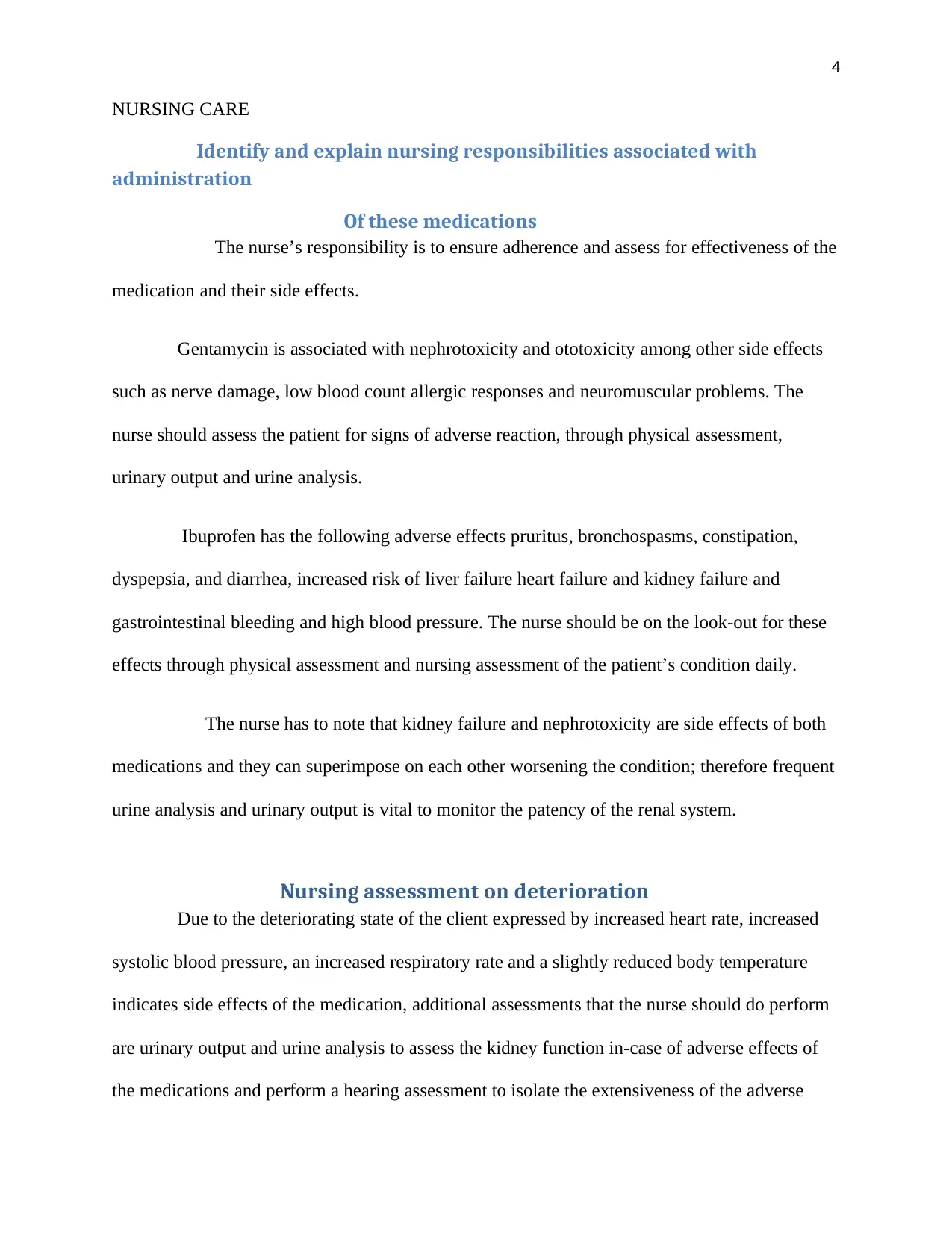
4
NURSING CARE
Identify and explain nursing responsibilities associated with
administration
Of these medications
The nurse’s responsibility is to ensure adherence and assess for effectiveness of the
medication and their side effects.
Gentamycin is associated with nephrotoxicity and ototoxicity among other side effects
such as nerve damage, low blood count allergic responses and neuromuscular problems. The
nurse should assess the patient for signs of adverse reaction, through physical assessment,
urinary output and urine analysis.
Ibuprofen has the following adverse effects pruritus, bronchospasms, constipation,
dyspepsia, and diarrhea, increased risk of liver failure heart failure and kidney failure and
gastrointestinal bleeding and high blood pressure. The nurse should be on the look-out for these
effects through physical assessment and nursing assessment of the patient’s condition daily.
The nurse has to note that kidney failure and nephrotoxicity are side effects of both
medications and they can superimpose on each other worsening the condition; therefore frequent
urine analysis and urinary output is vital to monitor the patency of the renal system.
Nursing assessment on deterioration
Due to the deteriorating state of the client expressed by increased heart rate, increased
systolic blood pressure, an increased respiratory rate and a slightly reduced body temperature
indicates side effects of the medication, additional assessments that the nurse should do perform
are urinary output and urine analysis to assess the kidney function in-case of adverse effects of
the medications and perform a hearing assessment to isolate the extensiveness of the adverse
NURSING CARE
Identify and explain nursing responsibilities associated with
administration
Of these medications
The nurse’s responsibility is to ensure adherence and assess for effectiveness of the
medication and their side effects.
Gentamycin is associated with nephrotoxicity and ototoxicity among other side effects
such as nerve damage, low blood count allergic responses and neuromuscular problems. The
nurse should assess the patient for signs of adverse reaction, through physical assessment,
urinary output and urine analysis.
Ibuprofen has the following adverse effects pruritus, bronchospasms, constipation,
dyspepsia, and diarrhea, increased risk of liver failure heart failure and kidney failure and
gastrointestinal bleeding and high blood pressure. The nurse should be on the look-out for these
effects through physical assessment and nursing assessment of the patient’s condition daily.
The nurse has to note that kidney failure and nephrotoxicity are side effects of both
medications and they can superimpose on each other worsening the condition; therefore frequent
urine analysis and urinary output is vital to monitor the patency of the renal system.
Nursing assessment on deterioration
Due to the deteriorating state of the client expressed by increased heart rate, increased
systolic blood pressure, an increased respiratory rate and a slightly reduced body temperature
indicates side effects of the medication, additional assessments that the nurse should do perform
are urinary output and urine analysis to assess the kidney function in-case of adverse effects of
the medications and perform a hearing assessment to isolate the extensiveness of the adverse
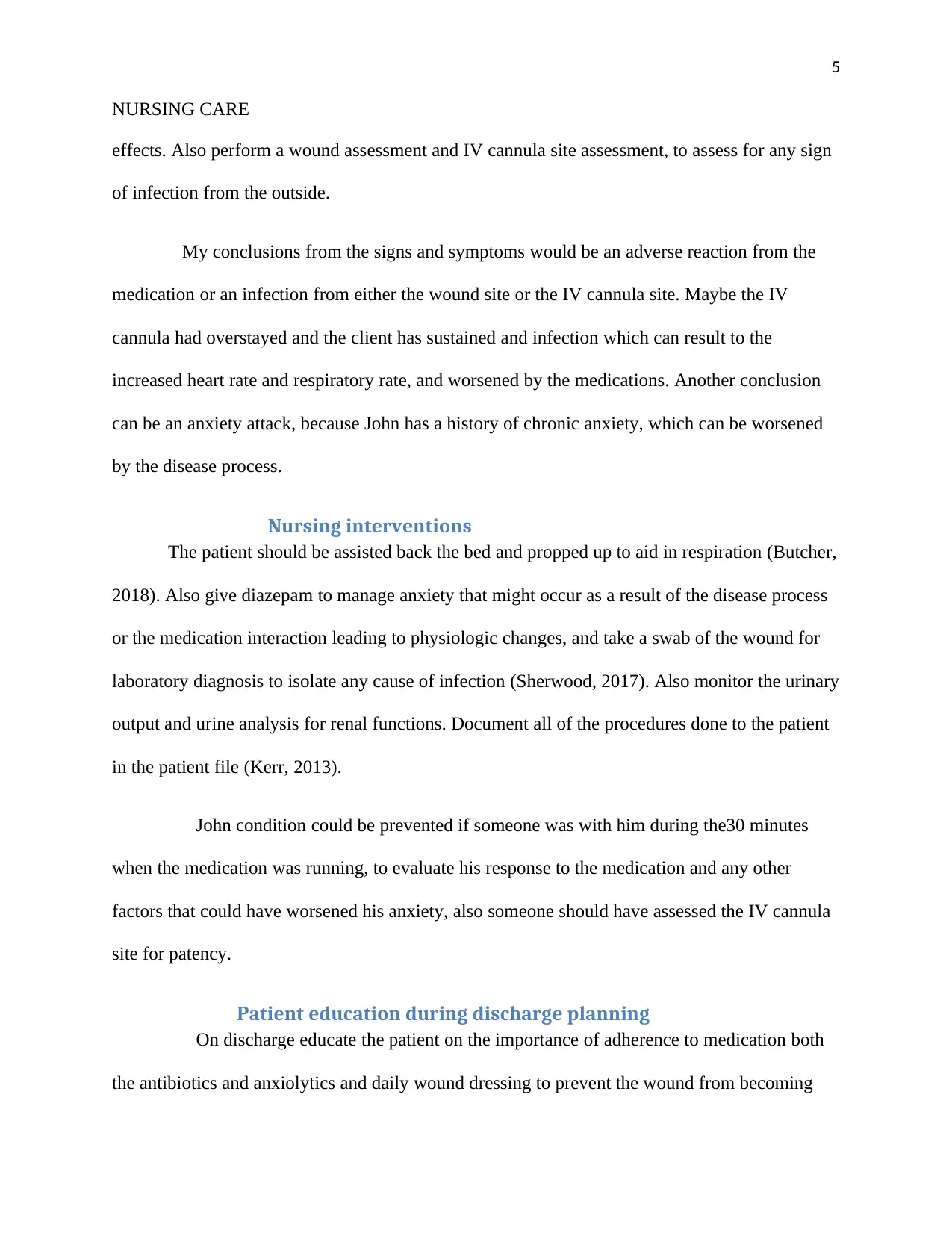
5
NURSING CARE
effects. Also perform a wound assessment and IV cannula site assessment, to assess for any sign
of infection from the outside.
My conclusions from the signs and symptoms would be an adverse reaction from the
medication or an infection from either the wound site or the IV cannula site. Maybe the IV
cannula had overstayed and the client has sustained and infection which can result to the
increased heart rate and respiratory rate, and worsened by the medications. Another conclusion
can be an anxiety attack, because John has a history of chronic anxiety, which can be worsened
by the disease process.
Nursing interventions
The patient should be assisted back the bed and propped up to aid in respiration (Butcher,
2018). Also give diazepam to manage anxiety that might occur as a result of the disease process
or the medication interaction leading to physiologic changes, and take a swab of the wound for
laboratory diagnosis to isolate any cause of infection (Sherwood, 2017). Also monitor the urinary
output and urine analysis for renal functions. Document all of the procedures done to the patient
in the patient file (Kerr, 2013).
John condition could be prevented if someone was with him during the30 minutes
when the medication was running, to evaluate his response to the medication and any other
factors that could have worsened his anxiety, also someone should have assessed the IV cannula
site for patency.
Patient education during discharge planning
On discharge educate the patient on the importance of adherence to medication both
the antibiotics and anxiolytics and daily wound dressing to prevent the wound from becoming
NURSING CARE
effects. Also perform a wound assessment and IV cannula site assessment, to assess for any sign
of infection from the outside.
My conclusions from the signs and symptoms would be an adverse reaction from the
medication or an infection from either the wound site or the IV cannula site. Maybe the IV
cannula had overstayed and the client has sustained and infection which can result to the
increased heart rate and respiratory rate, and worsened by the medications. Another conclusion
can be an anxiety attack, because John has a history of chronic anxiety, which can be worsened
by the disease process.
Nursing interventions
The patient should be assisted back the bed and propped up to aid in respiration (Butcher,
2018). Also give diazepam to manage anxiety that might occur as a result of the disease process
or the medication interaction leading to physiologic changes, and take a swab of the wound for
laboratory diagnosis to isolate any cause of infection (Sherwood, 2017). Also monitor the urinary
output and urine analysis for renal functions. Document all of the procedures done to the patient
in the patient file (Kerr, 2013).
John condition could be prevented if someone was with him during the30 minutes
when the medication was running, to evaluate his response to the medication and any other
factors that could have worsened his anxiety, also someone should have assessed the IV cannula
site for patency.
Patient education during discharge planning
On discharge educate the patient on the importance of adherence to medication both
the antibiotics and anxiolytics and daily wound dressing to prevent the wound from becoming
⊘ This is a preview!⊘
Do you want full access?
Subscribe today to unlock all pages.

Trusted by 1+ million students worldwide

6
NURSING CARE
septic and to encourage healing. Emphasize on the importance of bed rest, to allow the wound to
heal and teach on signs and symptoms of anxiety and how to avoid the triggering factors. Finally
tell the patient that they can get information from the hospital website. On discharge counsel the
patient on lifestyle modification, with a low-sodium diet because of the side effects of
medication (Peter, 2015).
NURSING CARE
septic and to encourage healing. Emphasize on the importance of bed rest, to allow the wound to
heal and teach on signs and symptoms of anxiety and how to avoid the triggering factors. Finally
tell the patient that they can get information from the hospital website. On discharge counsel the
patient on lifestyle modification, with a low-sodium diet because of the side effects of
medication (Peter, 2015).
Paraphrase This Document
Need a fresh take? Get an instant paraphrase of this document with our AI Paraphraser
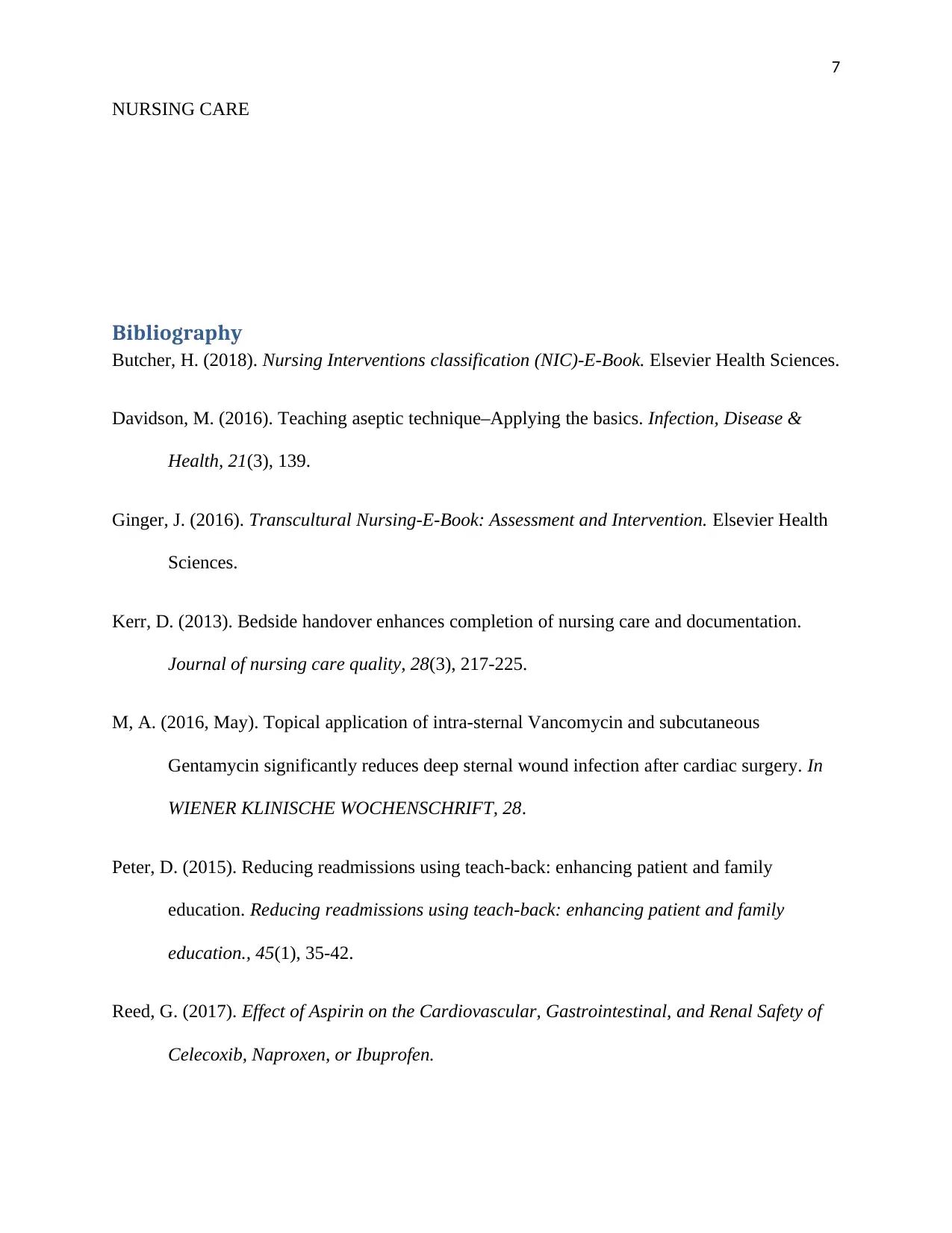
7
NURSING CARE
Bibliography
Butcher, H. (2018). Nursing Interventions classification (NIC)-E-Book. Elsevier Health Sciences.
Davidson, M. (2016). Teaching aseptic technique–Applying the basics. Infection, Disease &
Health, 21(3), 139.
Ginger, J. (2016). Transcultural Nursing-E-Book: Assessment and Intervention. Elsevier Health
Sciences.
Kerr, D. (2013). Bedside handover enhances completion of nursing care and documentation.
Journal of nursing care quality, 28(3), 217-225.
M, A. (2016, May). Topical application of intra-sternal Vancomycin and subcutaneous
Gentamycin significantly reduces deep sternal wound infection after cardiac surgery. In
WIENER KLINISCHE WOCHENSCHRIFT, 28.
Peter, D. (2015). Reducing readmissions using teach-back: enhancing patient and family
education. Reducing readmissions using teach-back: enhancing patient and family
education., 45(1), 35-42.
Reed, G. (2017). Effect of Aspirin on the Cardiovascular, Gastrointestinal, and Renal Safety of
Celecoxib, Naproxen, or Ibuprofen.
NURSING CARE
Bibliography
Butcher, H. (2018). Nursing Interventions classification (NIC)-E-Book. Elsevier Health Sciences.
Davidson, M. (2016). Teaching aseptic technique–Applying the basics. Infection, Disease &
Health, 21(3), 139.
Ginger, J. (2016). Transcultural Nursing-E-Book: Assessment and Intervention. Elsevier Health
Sciences.
Kerr, D. (2013). Bedside handover enhances completion of nursing care and documentation.
Journal of nursing care quality, 28(3), 217-225.
M, A. (2016, May). Topical application of intra-sternal Vancomycin and subcutaneous
Gentamycin significantly reduces deep sternal wound infection after cardiac surgery. In
WIENER KLINISCHE WOCHENSCHRIFT, 28.
Peter, D. (2015). Reducing readmissions using teach-back: enhancing patient and family
education. Reducing readmissions using teach-back: enhancing patient and family
education., 45(1), 35-42.
Reed, G. (2017). Effect of Aspirin on the Cardiovascular, Gastrointestinal, and Renal Safety of
Celecoxib, Naproxen, or Ibuprofen.
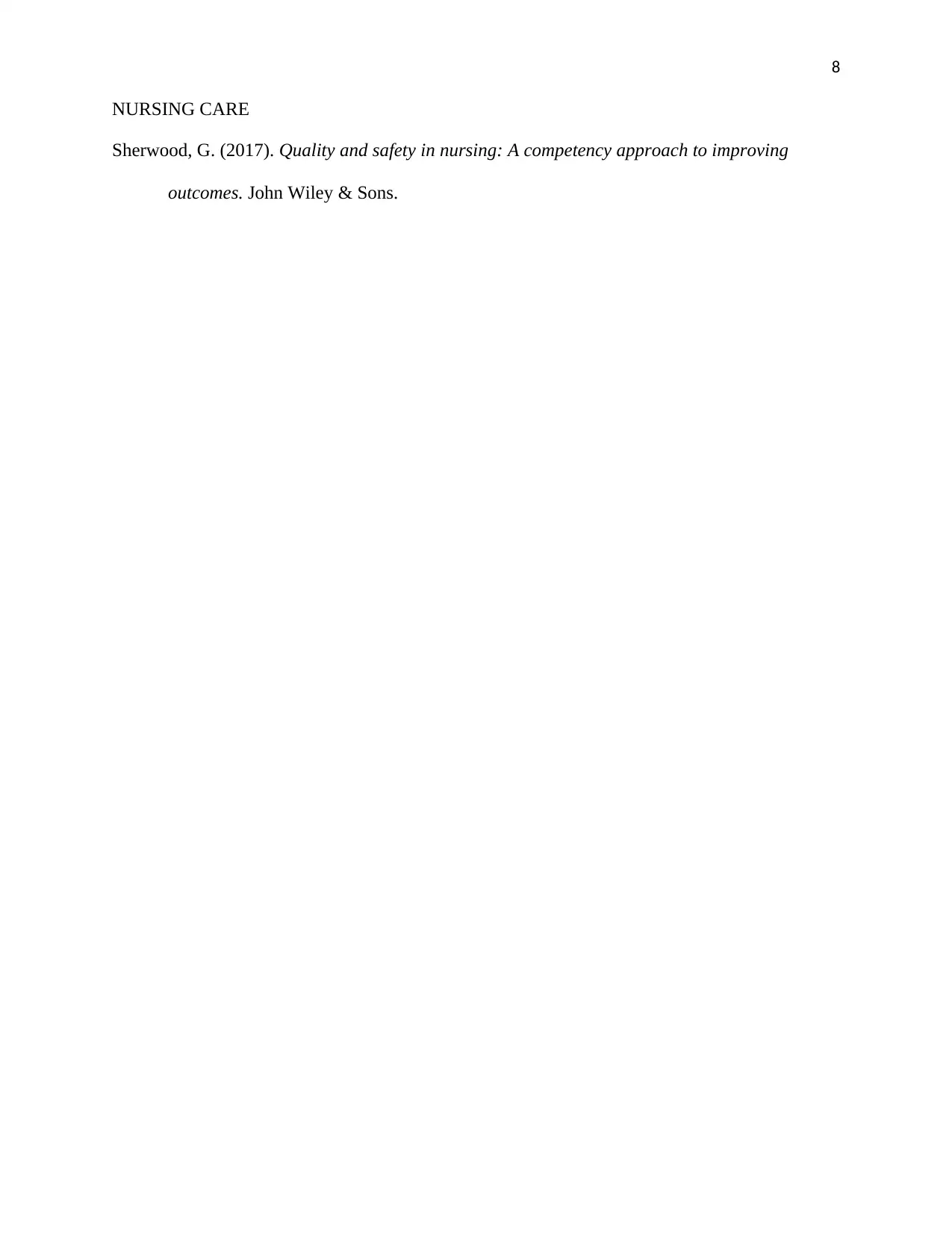
8
NURSING CARE
Sherwood, G. (2017). Quality and safety in nursing: A competency approach to improving
outcomes. John Wiley & Sons.
NURSING CARE
Sherwood, G. (2017). Quality and safety in nursing: A competency approach to improving
outcomes. John Wiley & Sons.
⊘ This is a preview!⊘
Do you want full access?
Subscribe today to unlock all pages.

Trusted by 1+ million students worldwide
1 out of 9
Your All-in-One AI-Powered Toolkit for Academic Success.
+13062052269
info@desklib.com
Available 24*7 on WhatsApp / Email
![[object Object]](/_next/static/media/star-bottom.7253800d.svg)
Unlock your academic potential
Copyright © 2020–2025 A2Z Services. All Rights Reserved. Developed and managed by ZUCOL.